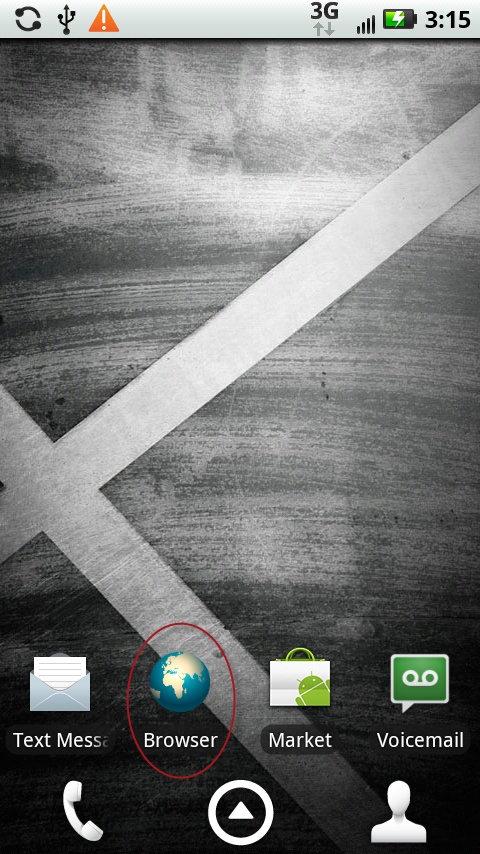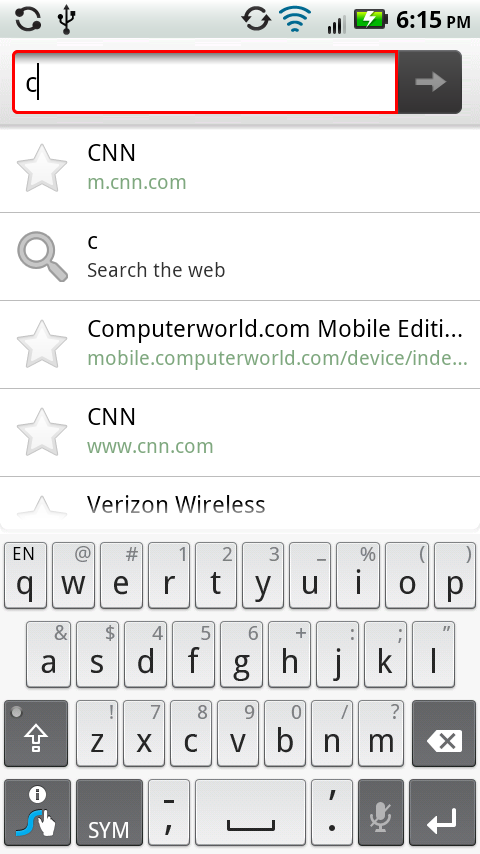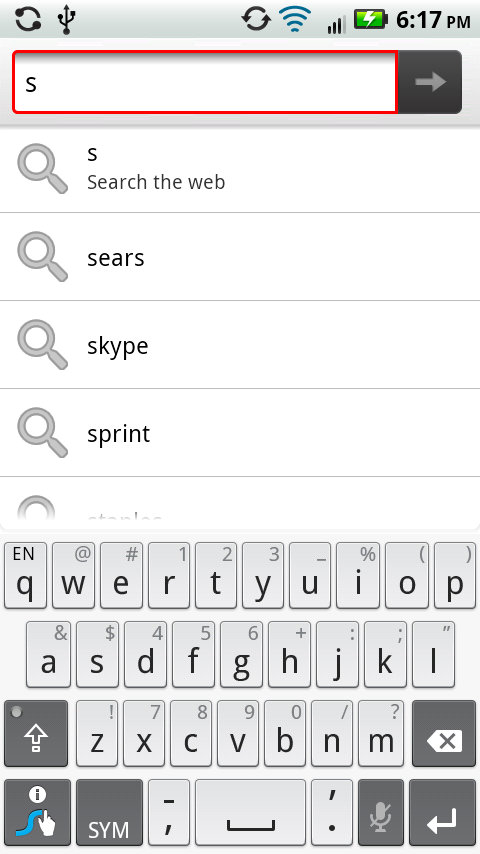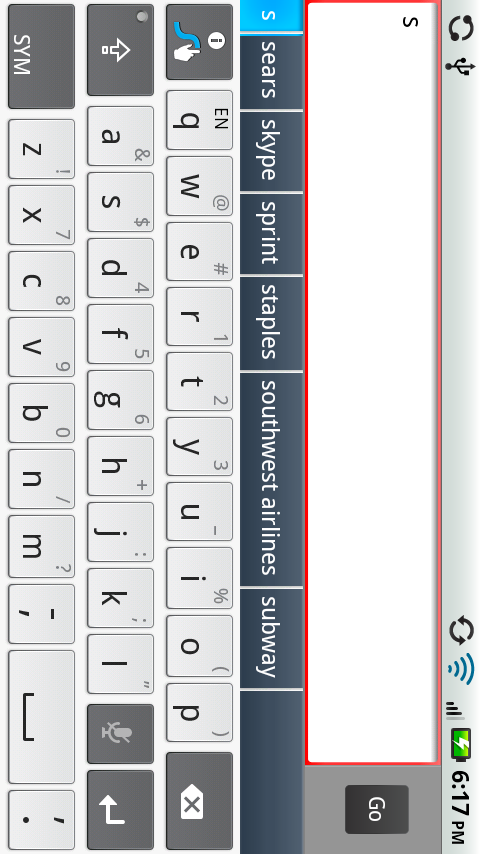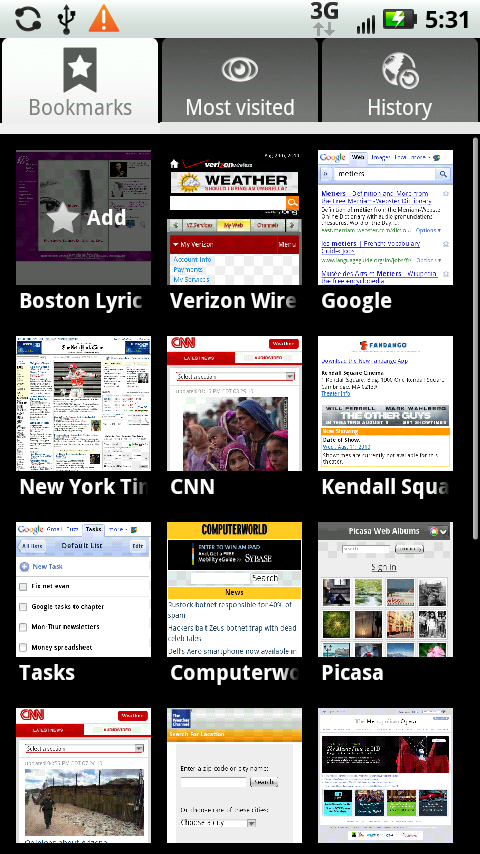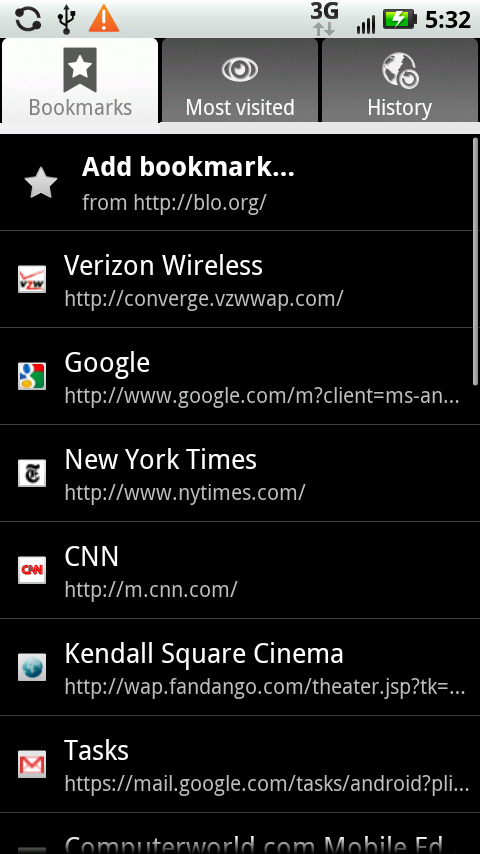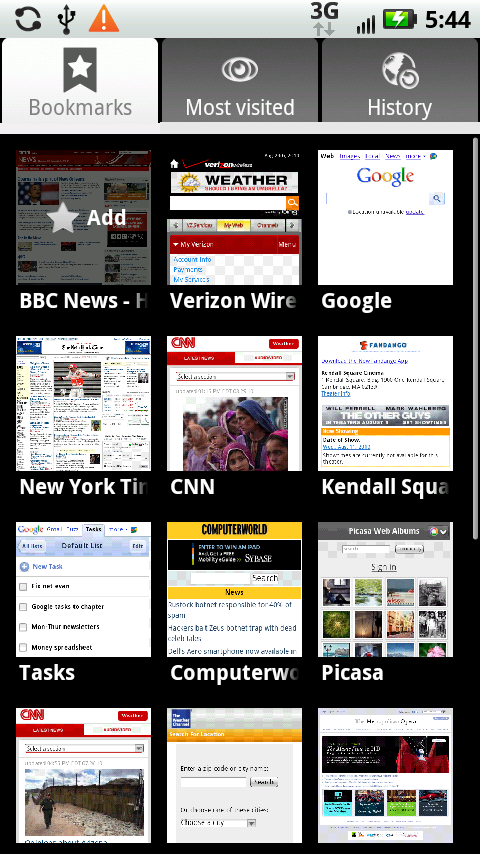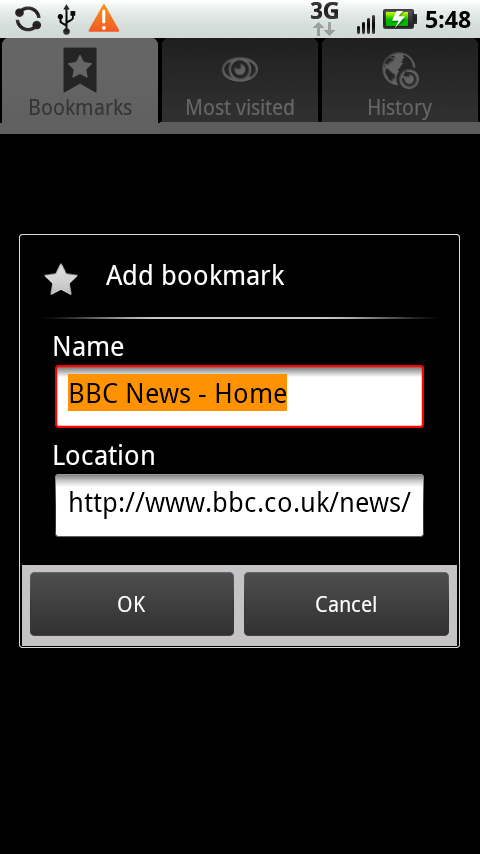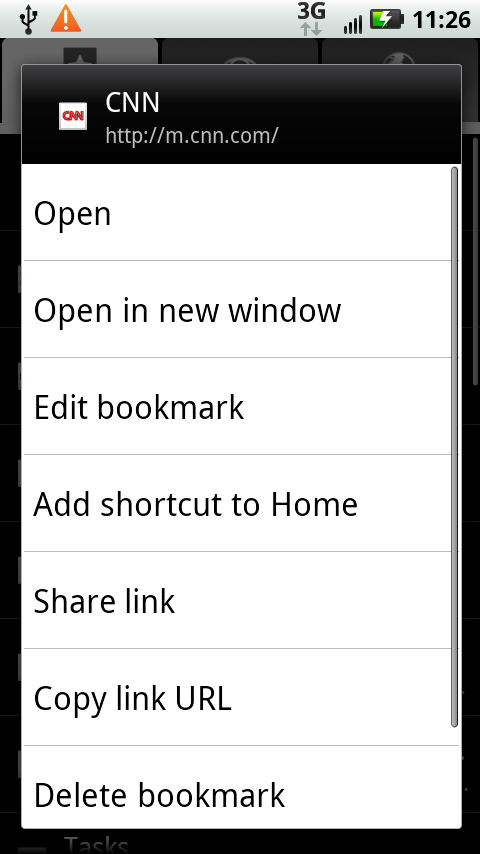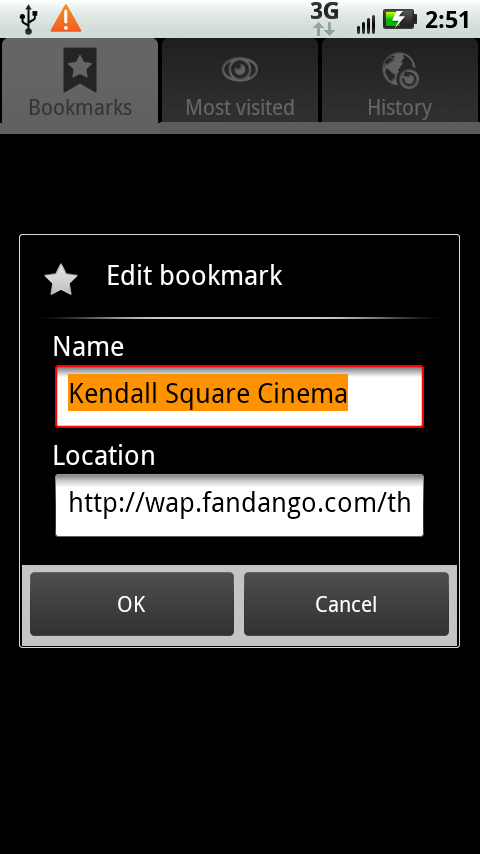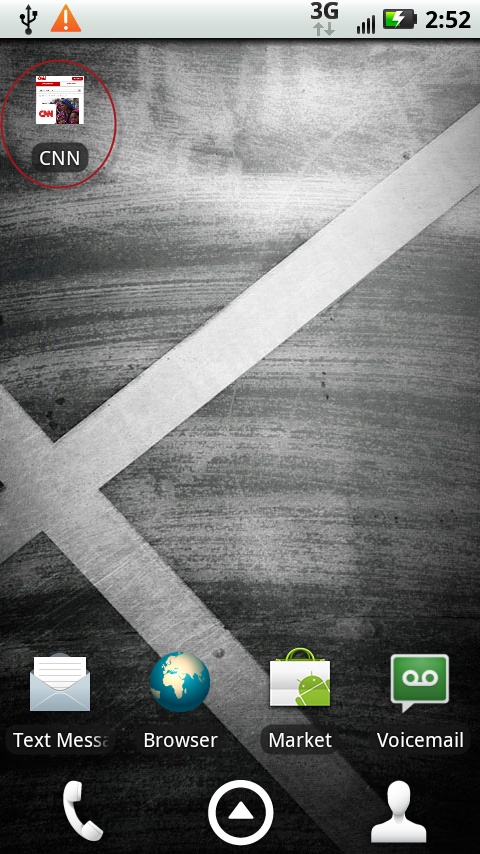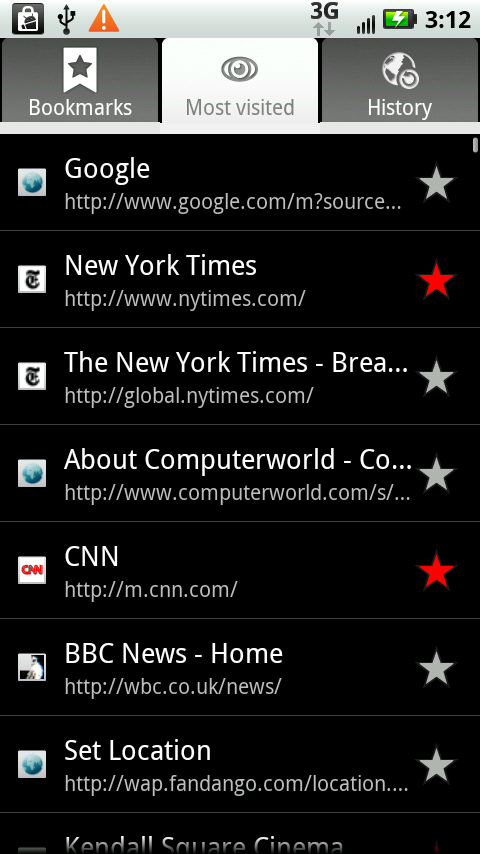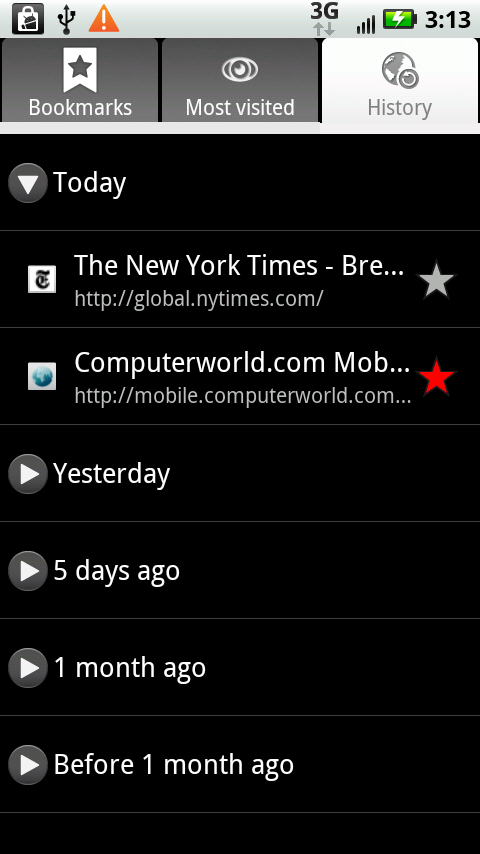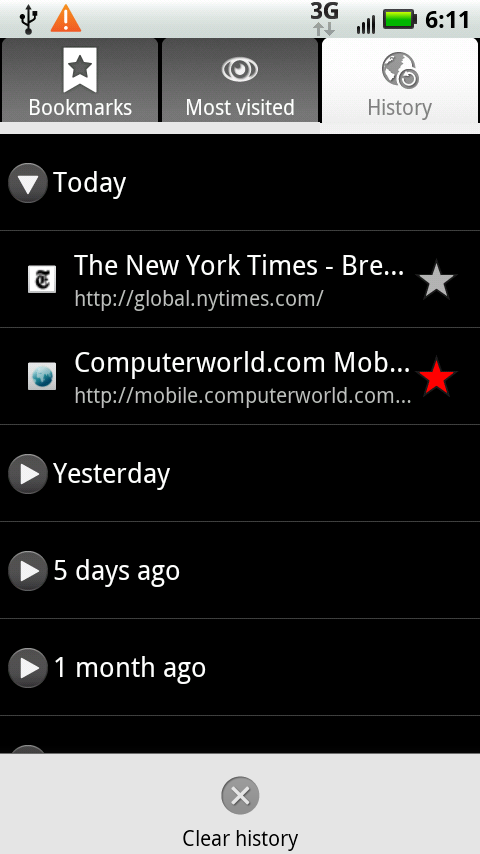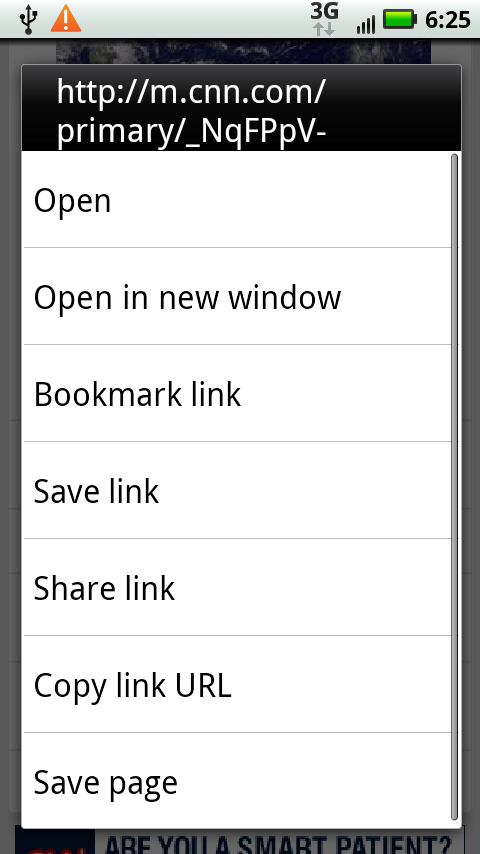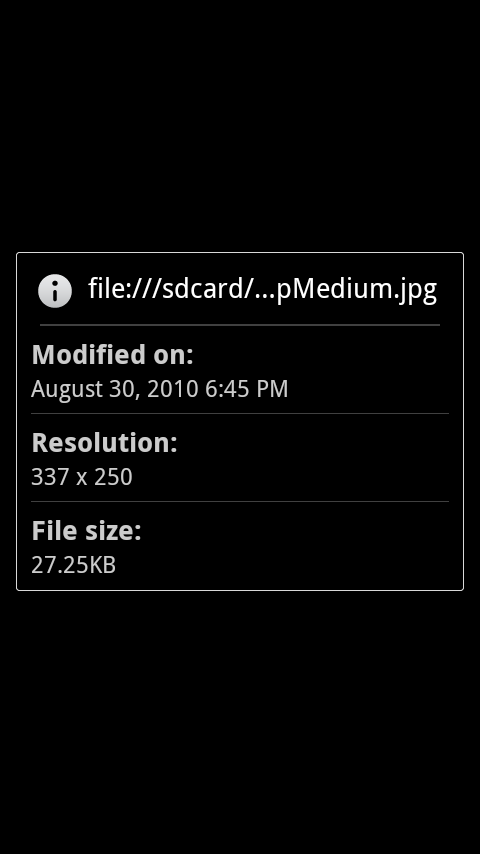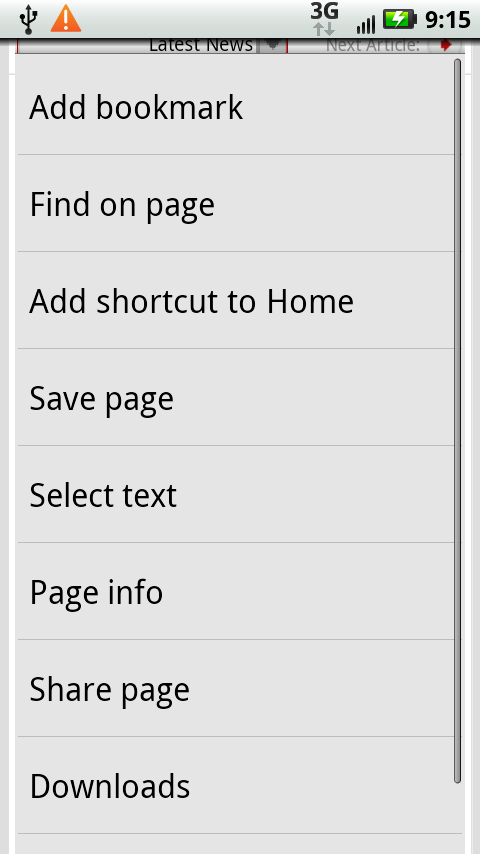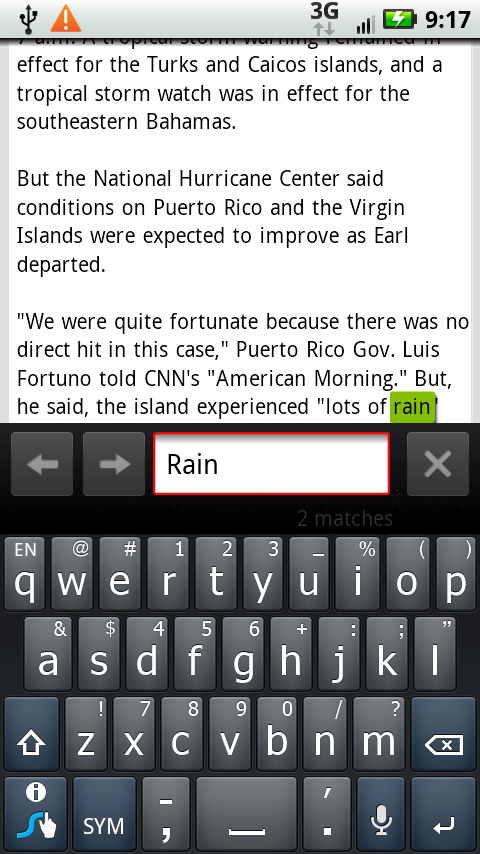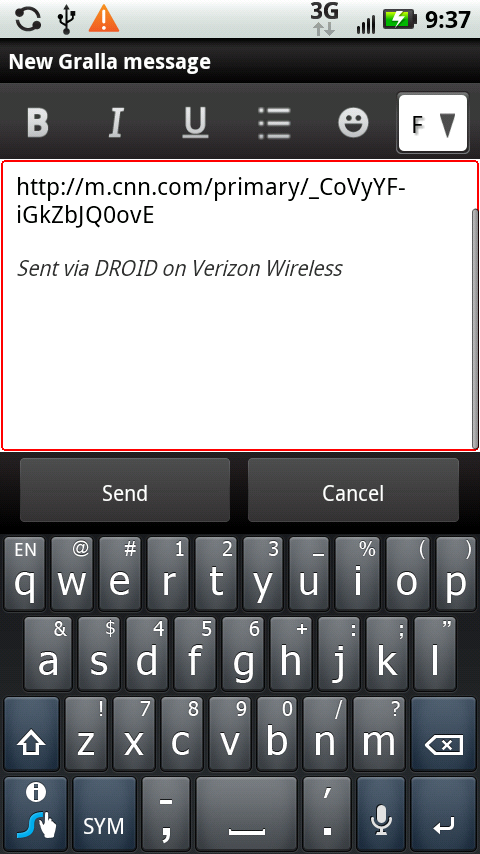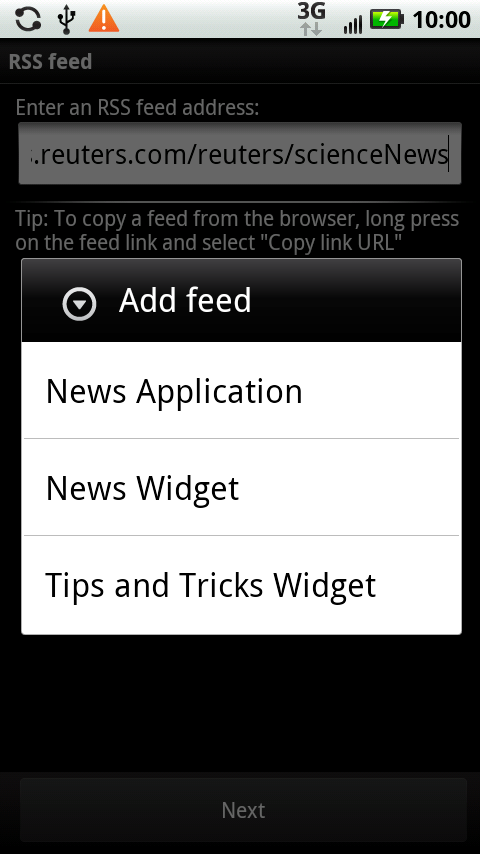Chapter 9. The Web
Once you’ve used your Droid X to skim movie reviews on your way to the theater, check out an online menu before you choose a restaurant, or find a newspaper to read on the train, you may wonder how you ever got along without having the Web in the palm of your hand. The screen may be smaller than your desktop display, but it’s big enough and clear enough to give you a satisfying Web experience wherever you go. With more and more web designers making their sites look good and work well on mobile devices like the Droid X, you may find yourself using the Browser more than any other app.
The Droid X’s Browser
To access the Web, tap the Browser icon on the Home screen or Application Tray.
Android’s browser has plenty of goodies, much like those in a computer browser, including bookmarks, AutoComplete for web addresses, cookies, password memorization, the ability to save and share pages, shortcuts, the ability to select and copy text…just about the whole nine yards. However, the browser itself is fairly bare bones, and its simplicity can at first be off-putting. But once you know your way around a bit, you’ll be browsing at warp speed. Here are the four main controls you need to know about:
Address bar. Here’s where you enter the URL—the web address—for a page you want to visit.
RSS button. Lets you subscribe to a news feed of the latest information, news, and blog posts from a site. See Getting the Facts with RSS for more information about RSS feeds.
Favorites. Tap this button, and you’ll add the current page to your Favorites list.
Menu key. This key isn’t on the screen itself. Rather, it’s the hard button on the lower left. Press this button to get at most of the browser’s features, including going back and forward, opening a new browser window, seeing and managing your bookmarks, and more.
To see all your open windows, and to close any that you don’t want open anymore, tap Windows. To reload the current web page you’re visiting, tap Refresh. (You may want to refresh the page to see if there’s new content on the page since you first visited, or if the page didn’t load completely and you want to try again.) There’s also a Forward button, and a More button, with plenty more options, as you’ll see in the next section.
Basic Navigation and Managing Windows
There are two things conspicuously absent on the Droid X browser—a Forward button and Back button. But you can still go forward and back to pages you’ve previously visited. To go forward, press the Menu key and select Forward. To go back, press the Menu key and select Back.
Just as with a browser on a computer, your Droid X browser lets you open multiple windows and visit multiple sites. It’s just harder to tell that you’re visiting multiple sites, because the Droid X’s browser doesn’t have enough room for tabs. Instead, the Droid X opens multiple windows, one for each site you’re visiting. When you’re in the browser, tap the Menu key and select Windows, and you see a list of all of your open windows. Tap any to view the site in its own window. Tap the X next to it to close the window. And tap “New window” at the top of your screen to open a new window.
Navigating a Web Page
Head to a web page, and most of the time you see an entire page, laid out with the same fonts, links, pictures, and so on, as if you were visiting it using a computer with a much larger screen. Of course, looking at an entire web page on the Droid X’s 4.3-inch screen isn’t the same thing as looking at a web page on a 21-inch monitor. The type is minuscule, the photos small, the links hard to detect. But letting you see the entire screen at once makes a good deal of sense, because at a glance, you can see what section of the page you want to view.
That’s where the fun begins. You can use the Droid’s zooming and scrolling capabilities to head quickly to the part of the page you want to view, and then zoom in.
You’ve got three ways to do so:
Rotate the Droid X. Turn it 90 degrees to the left or to the right. The Droid X changes the orientation of the website to fill the wider view, and while doing so, zooms in.
Use the two-finger spread. Put two fingers on the Droid X’s screen on the areas where you want to zoom in, and move your fingers apart. The web page stretches and zooms in. The more you spread, the greater the zoom. Pinch your fingers together to zoom back out. You may need to do the two-finger spread and pinch several times until you get the exact magnification you want.
Double-tap. Double-tap with a finger on the section of the page where you want to zoom. Double-tap again to zoom out. You can’t control the zoom level as finely with the double-tap as you can using the two-finger spread.
Once you’ve zoomed in, you scroll around the web page by dragging or flicking your finger—the same kind of navigation you use for other apps on the Droid X.
Multiple Windows
The Droid X’s browser doesn’t confine you to a single window—you can use multiple ones, and easily switch among them. In fact, you may have multiple windows open without even knowing it.
Press the Menu key, and from the screen that appears, tap Windows. You see a list of all the browser windows you have open. Tap any you want to switch to. To close any window, tap the ![]() button next to the window. To open a new window, press the
button next to the window. To open a new window, press the ![]() button.
button.
Web Pages Designed for Mobile Phones
As you browse the Web, you may come across sites that differ significantly when viewed on the Droid X (or other smartphones) compared with the exact same sites viewed on a computer. That’s because web designers have created pages specifically designed to be viewed with mobile phones, taking into account that mobile phones have smaller screens than computer screens.
CNN, for example, has sites designed especially for mobile viewing. Head to the same site at the exact same time of day with a smartphone and a computer, and you see very different pages, even though the content of the pages is the same.
These pages are formatted to be read on the phone, so very often they don’t include complex layouts, and instead present articles and other information in scrollable lists. They generally don’t allow you to zoom in and zoom out. You’ll navigate primarily by scrolling and clicking links.
The Address Bar
The address bar is the box at the top of the browser where you type the URL of the website you want to visit. Just to the right of it are either one or two buttons (and sometimes three), depending on the web page you’re visiting:
RSS Button
 . This button appears when a site includes an RSS feed, as described earlier in this chapter. See the section on RSS feeds on Getting the Facts with RSS for more details.
. This button appears when a site includes an RSS feed, as described earlier in this chapter. See the section on RSS feeds on Getting the Facts with RSS for more details.Stop
 . When a page is loading, this button appears so you can stop the page from loading.
. When a page is loading, this button appears so you can stop the page from loading.
When you type an address and head to a page, a small bar above the address bar shows you the status—how much of the page has loaded (the red part), and how much is left to go (the gray part).
Note
The bar indicating your page’s loading status is only an approximation, so don’t take it for the absolute truth.
Typing an Address
To type a URL into the address bar, first tap the bar. The current URL will be highlighted in orange. Then use the keyboard to type an address. As you type, the Droid X displays sites you’ve visited that match the letters you type. So when you type the letter C, for example, it may display Computerworld.com, CNN.com, and so on. It may be a very long list.
You’ll notice, though, that it might also display URLs that don’t start with the letter C. If you’ve previously visited a site about the international opera star Cecilia Bartoli, you may see that site come up when you type C. That’s because the Droid X’s browser looks through your browsing history and Bookmarks list (see the next page), and looks for all matches to that letter, not just in URLs but also text in the page’s title. When it displays its list as you type, it includes both the page’s title and the URL.
As you continue to type, the list narrows down, and matches only those sites that match the letters you’re typing. So if you type com, cnn.com no longer appears your list, but computerworld.com does. When you see the site you want to visit, just tap its listing. You head straight there. If there’s no match on the list, you’ll have to type the entire URL.
You may find it easier to type URLs if you rotate the Droid X 90 degrees. That way, the keys are much larger, and you’ll be able to see more of the URL as you type. When you type this way, matching sites and terms show up in boxes just above the keyboard, rather than in a list.
Note
Don’t bother to type the http:// part of a web address. The Droid X knows to put that in for you. You do, however, need to type in the .com or other ending, such as .edu. After you’ve typed in the address, tap the arrow button ![]() , and you head to the page.
, and you head to the page.
You can also use the address bar to search the Web. Just type your search term, but don’t add a .com ending. Your browser will search the Web for the term, using (what else?) Google.
Bookmarks
Just as with computer-based browsers, the Droid X’s browser lets you save your favorite sites as bookmarks—sites you can easily visit again without having to retype their URLs. In fact, before you even use your browser, it has bookmarks for a few popular sites, including eBay and Amazon.com.
To see your bookmarks, press the Menu key and then tap Bookmarks. You see all your bookmarks, either displayed as a list or as a group of thumbnails of each of the bookmarked pages, so that you can distinguish them visually.
To switch back and forth between the views, when you’re viewing your bookmarks, press the Menu key and then select “List view” or “Thumbnail view”.
No matter which view you use, to go to a bookmarked site, tap the site. Voilà—you’re there.
Note
The bookmarks in your Droid X browser don’t sync back to your computer. However, if you use the Firefox browser, you can sync bookmarks between the Droid X and any other computer you use—Windows, Mac, or even Linux. Firefox includes a feature called Firefox Sync that automatically synchronizes all your bookmarks among all your computers and devices. At this writing, Firefox isn’t officially available for the Droid X, but it might be by the time you read this. You may have to install the Firefox Sync add-in for your desktop Firefox, depending on which version of the browser you use. For details, go to www.mozilla.com/en-US/firefox/sync/.
Adding a Bookmark
Whenever you visit a web page you want to add as a bookmark, tap the Bookmark button ![]() . The Bookmarks page appears. If you’re in Thumbnail view, the current page appears in the upper-left corner of the page with a star and the word “Add” on it. If you’re in List view, the current page shows up at the top of the list with the words “Add bookmark”.
. The Bookmarks page appears. If you’re in Thumbnail view, the current page appears in the upper-left corner of the page with a star and the word “Add” on it. If you’re in List view, the current page shows up at the top of the list with the words “Add bookmark”.
Tip
If you sometimes find yourself with a slow Internet connection, and wish there was a way to browse the Web faster, here’s a bookmark you should add to your list: http://google.com/gwt/n. It hides most graphics, and lets you browse the Web much more quickly on a slow connection.
Here you can edit the name or the actual URL of the bookmark. In the Name box, type a different name if you want one, and in the Location box, type a different location. Then press OK. The bookmark is added to your list.
Managing Bookmarks
The Droid 2 lets you do more than just go to bookmarks. You can delete them, share them, edit them, and so on. To do it, head to Bookmarks and then press the Menu key. Then hold your finger on the bookmark you want to edit or manage. A menu appears with the following choices:
Open. Opens the bookmarked site in the current window. So if, for example, you’re at www.google.com, open your bookmarks, and then choose www.cnn.com from your bookmarks, www.cnn.com opens in the window where www.google.com had previously been open.
Open in new window. Opens the bookmarked site in a new window. So if you’re at www.google.com, open your bookmarks, and then choose www.cnn.com, www.cnn.com opens in a window of its own.
Edit bookmark. Brings up a page that lets you edit the name and location of the bookmark. It looks much like the page for adding a bookmark.
Add shortcut to home. Tap this option, and a shortcut to the bookmarked page is added to your Home screen. When you tap the bookmark, it opens the browser to that site. You can move and delete the icon after you add it (Adding Widgets, Folders, Shortcuts, and Wallpaper).
Share link. Tap to share the link of the bookmark by email or text message.
Copy link URL. Tap to copy the bookmark’s URL to the clipboard so you can then paste it somewhere else, like into a document or email.
Delete bookmark. Deletes the bookmark. After you tap it, you get a warning that you’re about to delete the bookmark, just in case you want to reconsider, or tapped this option by accident.
Set as homepage. Tap this, and from now on whenever you open a new window, it opens to that site.
Most Visited and History Lists
When you go to your Bookmarks, you see two more ways to browse sites that you’ve been to before—“Most visited” and History. The Droid X keeps track of sites you’ve visited, and puts these two lists together based on that. They’re great ways, in addition to Bookmarks, to head back to sites you’ve visited before without having to type—or even remember—the web address.
To see the “Most visited” list, tap the “Most visited” ![]() button at the top of the Bookmarks screen. To see the History list, tap the History button
button at the top of the Bookmarks screen. To see the History list, tap the History button ![]() .
.
Note
The “Most visited” and History lists don’t give you the option of viewing sites as thumbnails, only as lists.
These lists work much the like the Bookmarks list—tap the site you want to visit. You’ll notice one difference between these lists and the Bookmarks list: The sites all have stars to the right of them, some red, some gray. A red star indicates that the site is on your Bookmarks list. Tapping a gray star adds that site to your Bookmarks (and turns the star red). To remove a site from your Bookmarks list, tap a red star. It turns gray, and the site gets removed from your Bookmarks list.
The History list shows you not just sites you’ve visited today, but yesterday, five days ago, a month ago, and even before a month ago. Rather than show you all the sites you visited before today, the Droid X shows the day (Yesterday, “5 days ago”, and so on), with an arrow next to it. Tap the arrow, and you see the full list of sites for that day.
Editing and Managing the Most Visited List
Just as with Bookmarks, you can edit and manage the Most Visited list. Hold your finger on the site you want to edit or manage, and a menu appears, like the one you see for managing Bookmarks.
The lists are nearly identical, with a few minor differences:
Editing and Managing the History List
You manage the History list just like you do the Bookmarks and Most Visited lists. Hold your finger on the site you want to edit or manage, and a menu appears like the one you see for managing Bookmarks or “Most visited”.
There’s one thing you can do to your History list that you can’t do with either the Bookmarks list or the “Most visited” list: You can clear your entire history. If you feel guilty about visiting sites for any reason, you can get rid of them all. While in the History list, press the Menu key, and then select “Clear history”. Your slate will be wiped clean.
Tapping Links
When it comes to links, the Droid X’s web browser works largely like any computer browser, except that you tap a link rather than click it. Tap the link, and you get sent to a new web page.
Note
Sometimes when you click a link, instead of loading a web page, the Droid X may take a different action. For example, if the link is to an email address, it will open the Email app, with a new message addressed to the link’s email address.
But this is the Droid X, so there’s a lot more you can do with links than just tapping them. Hold your finger on a link, and a menu appears with these options:
Open. Opens the linked page in the current window.
Open in new window. Opens the linked page in a new window.
Bookmark link. Puts the link into your Bookmarks list.
Save link. Saves the linked page to the Download folder on your SD card. To see how to view the link and anything else in the Download folder, see Using the Droid X Files Application.
Share link. Lets you share the link via email or text messaging.
Copy link URL. Tap to copy the link’s URL to the clipboard, so you can paste it somewhere else, such as in a document or email.
Save page. Tap to save the page you’re on—not the linked page—to your SD card. After you’ve saved your first page, this menu option changes to “Saved pages”. Tap it, and you see a list all the pages you’ve saved, and also get the option of saving the current page. To see a page you’ve saved, tap it. You see the text, graphics, links, and so on.
Note
If you hold your finger on a graphic that’s also a link, a “Save image” option appears, which lets you save the graphic to your SD card.
Other Nifty Things to Tap
The Droid X is smart enough that you can to take actions based on what you see on web pages, without even having to use links:
When you see a phone number on the Web and want to call it, just tap it. The Droid X dialer launches, with the number already entered. Tap the phone icon to make the call.
When you see an address on the Web and want to see a map of its location, tap it. Google Maps launches, centered on the location.
When you see an email address, even if the address hasn’t been created as a link, tap it, and the Email app opens, with a new message already addressed to that address.
Saving Online Images
When you’re browsing the Web, sooner or later you’ll come across a picture you’d like to save. For example, if a friend posts a picture from your birthday party on Facebook, you can save it on your Droid X and then share it with others.
There’s a quick and easy way to save that image. Hold your finger on the picture for a second or two, and a menu appears with the following five options:
Save image. Downloads the picture to your Download folder on your SD card. See the next section to learn how to go back and view all the pictures in this folder.
View image. Opens the image in its own page. As a practical matter, this option doesn’t do much, because it doesn’t make the image any larger or smaller—you’re seeing the same image, just on its own rather than on a web page.
Set as wallpaper. Tap and the image becomes your Droid X’s wallpaper—nifty!
Share image links. As always, you can share the link to the image via email or text messaging.
Saved pages. Tap and you can download the entire page to your Download folder.
Tip
If the picture is also a link, the menu shows the usual options for bookmarking the link, saving the link, and so on.
Viewing Images and Downloaded Pages
Now that you’ve got graphics saved on your Droid X, how can you view them? When you’re in the browser, tap the Menu key, and then select More→Downloads.
You come to a list of all your pictures. They’re listed by file name, which may or may not give you a clue to their contents. If you see something like Serena_Williams.jpg, you’ll know it’s a photo of the tennis great Serena Williams. But if you see something like _5HABau-IVgrZ2QWCTqil.jpg, you won’t have a clue what it is.
Underneath the name, you’ll find the address of the site you downloaded it from, along with the file size and, to the right, the date of download.
Tap any picture to view it. To see information about the picture, tap the screen, and then tap the small i button that appears. You see information about the screen resolution, file size, and download date.
Finding Text, Copying Text, Getting Page Information, and More
When you browse the Web, you may be on a mission of sorts—looking for a specific piece of information. So when you come to a web page, you might be looking for a specific word or phrase. Or you may also come across text on the Web that you want to use elsewhere, say in an email or a document.
The Droid X browser can do all that and more. To do it all, when you’re on a web page, press the Menu button, and then select More from the screen that appears. You’ll find a menu of options that lets you do any of the following:
Add bookmark. Tap this option and then add the bookmark in the usual way (Bookmarks).
Find on page. Looking for text on a page? Tap this option, and a search box appears, along with the keyboard. Type the text or phrase you’re searching for, and the Droid X finds the text, sends you to its location on the page, and highlights it in green. To find the next time the text or phrase is mentioned, tap the right arrow. To find a previous mention of it on the page, tap the left arrow. To exit from search, tap the X to the right of the search box.
Add shortcut to Home. Adds a link to the page to your Home screen, as described on Customizing the Home Screen and Panes.
Saved pages. If you’ve previously saved a page on your SD card (Other Nifty Things to Tap), you can find it by tapping this button to see a list of all the pages you’ve saved. Tap any to view it. You also have the option of saving this page—simply tap “Save current page” at the top of the list.
Select text. Copies text to the Droid X clipboard. First navigate to the section of the web page where you want to copy text from. Then press the Menu key and select More→“Select text”. After that, the web page appears again. Drag your finger to select the text you want to copy to the clipboard. When you release your finger, the text is selected, and you get a notification that the text was copied. You can now paste it into an email, a document, and so on.
Page info. Tap to see basic information about the page—title and web address.
Share page. Tap to share the page via email or text messaging. You don’t actually share the page itself; instead you send a link to it. Selecting this option copies the URL to an email message or a text message. You can then select an address, and add explanatory text to the message as well.
Downloads. Brings you to the Download folder on your SD card. If you’ve saved pictures here, you see a list of them. See Checking Space on Your SD Card for more details.
Settings. Here’s how you can change countless browser settings, including the size of the text displayed, the default zoom level, and so on.
Getting the Facts with RSS
If you’re reading this book, you’re not only a Droid X user, but you’re probably also a victim of information glut. You’ve got too much information battling for a shrinking amount of your time. There are countless websites and blogs out there with useful and interesting information you’d like to get to, but who has the time?
That’s where RSS (Really Simple Syndication) comes in. With RSS, you subscribe to feeds, which are summaries and excerpts of information provided by many thousands of sources across the Internet, ranging from big, internationally known news sources such as Reuters and the New York Times, to some guy in his basement who knows everything there is to know about 18th-century lute making and wants to share that information with the world. RSS is particularly popular among bloggers.
When you subscribe to an RSS feed, you see a list of the latest blurbs from a news source. In many instances, those summaries are all you want. Think of them as your own personalized news ticker. However, if you want more information about those summaries and blurbs, you can tap one and get sent to a web page with the full story or more information.
As explained on The Address Bar, to subscribe to an RSS feed, tap the RSS button ![]() that appears whenever you’re on a page that has an RSS feed. The button doesn’t appear unless there’s an RSS feed available. Tap the button, and a screen appears asking you where you want to add the feed—to your News widget, News application, or some other location. Select the location, and follow the instructions for adding the feed. You can then read the news using the application or the widget.
that appears whenever you’re on a page that has an RSS feed. The button doesn’t appear unless there’s an RSS feed available. Tap the button, and a screen appears asking you where you want to add the feed—to your News widget, News application, or some other location. Select the location, and follow the instructions for adding the feed. You can then read the news using the application or the widget.
Online Privacy and Security
Whether you browse the Web with a computer or with Droid X, there are potential security and privacy dangers out there—cookies, pop-ups, and malicious websites. So the Droid X browser, just like its big brother browsers on computers, includes the tools you need to keep you safe and protect your privacy when you browse the Web.
Pop-up Blocker
What’s top on your list of web annoyances? Most likely at the pinnacle are pop-ups and pop-unders—ugly little windows and ads that either take an in-your-face stance by popping up over your browser so that you have to pay attention, or pop under your browser so that you don’t notice they’re there until you close a browser window, and then demand your attention.
Sometimes these pop-ups and pop-unders are malicious, and if you tap them they attempt to install dangerous software or send you to a malicious website. Sometimes they’re merely annoying ads. Sometimes, though, they may actually be useful, like a pop-up that shows a seating chart when you’re visiting a ticket-buying site. The Droid X browser includes a pop-up blocker, and like all pop-up blockers it can’t necessarily distinguish between bad pop-ups and pop-unders and good ones, so it blocks them all.
However, if you’re on a website that uses pop-ups that you want to see, you can turn off the pop-up blocker. Press the Menu key, select More→Settings, and then tap the green checkbox next to “Block pop-up windows”. When you leave the site and want pop-ups blocked again, go back to the setting and tap it to turn it on. A green checkmark will appear next to the setting, and you’ll be protected.
Cookies
Cookies are tiny bits of information that some websites store on the Droid X for future use. When you register for a website and create a user name and password, the website can store that information in a cookie so you don’t have to retype it every time. Cookies can also remember your habits and preferences when you use a website—your favorite shipping method, or what kinds of news articles you’re likely to read.
The Droid X browser gives you control over how you handle cookies—you can either accept them, or tell the browser to reject them. Keep in mind that if you don’t allow cookies on your Droid X, you may not be able to take advantage of the features on many sites.
To bar websites from putting cookies on your Droid X, when you’re in the browser, press the Menu key, select More→Settings, and scroll down to the Privacy Settings section. Tap the green checkbox next to “Accept cookies”.
The checkmark disappears, and from now on, no cookies will be put on your Droid X. You can always turn this setting back on again, if it causes problems with web browsing.
While you’re in Privacy Settings, you can also delete all the cookies that have been put on your Droid X. Tap “Clear all cookie data”. You get a warning that you’re about to delete your cookies. Tap OK to clear them, or Cancel if you change your mind.
Privacy Settings
While you’re in the Privacy section of the browser’s settings screen, you can also take several other actions to make sure your privacy isn’t invaded. For example, you can clear your browsing history so that others who use the browser can’t see where you’ve been.
You can also tap “Clear cache” to clean out website information your browser has stored on your Droid X. A cache is information the browser stored on your Droid X so it won’t have to get that information from the Web the next time you visit that site. The cache speeds up browsing, since it’s faster to grab the information—a website image, for example—from your Droid X than from the Web. Tap “Clear cache” if you want to clear all that information out, if you worry that the information there poses a privacy risk.
At many websites, you log in by typing a user name and password, and other information such as your address. The Droid X browser remembers those user names, passwords, and other information, and fills them in for you automatically when you next visit. That’s convenient, but it also presents a privacy risk, because someone else using your Droid X can log in as you.
If that concerns you, there are two actions you can take. First, in the Privacy section, tap the green checkmark next to “Remember form data”. When you turn it off, the browser won’t remember user names, passwords, and other information you type into forms. You can always turn it on again. To delete all the information already stored on your Droid X, tap “Clear form data”. Next, scroll down to the Security Settings area and turn off the checkbox next to “Remember passwords”. To clear out saved passwords, tap “Clear passwords”.
Using Other Browsers
The browser built into the Droid X is a good one, but you may prefer a different one. The Droid X’s open approach means that you can download other browsers and use them instead of the Droid X’s built-in browser, or in addition to it.
There are a number of free alternative browsers you can download. Search the Android Market for them, or search for them on the Web. Opera (http://www.opera.com/mobile/) and Dolphin (http://browser.mgeek.mobi/) both work well. The popular Firefox browser has released a test version for Android phones, but as of this writing it’s still a bit buggy. However, by the time you read this, it might be finished and ready to go. Head to www.mozilla.com/en-US/mobile/ in your Droid X browser for details.
Why use an alternative browser? They add features that the Droid X’s built-in one doesn’t have. Firefox, for example, will sync your Droid X bookmarks with the bookmarks on your PC or Mac. Opera is faster than the browser built into the Droid X, because it compresses graphics before downloading them to your Droid X, and has other extras, such as syncing bookmarks with your PC and Mac. And Dolphin uses tabs so that you can easily jump back and forth between multiple Web sites.


